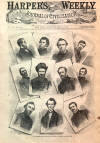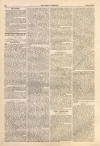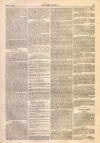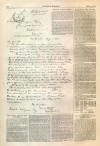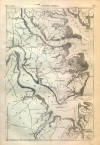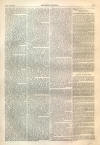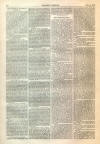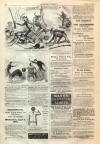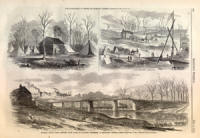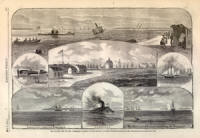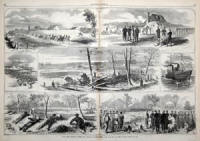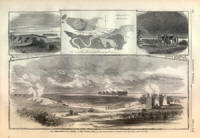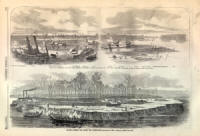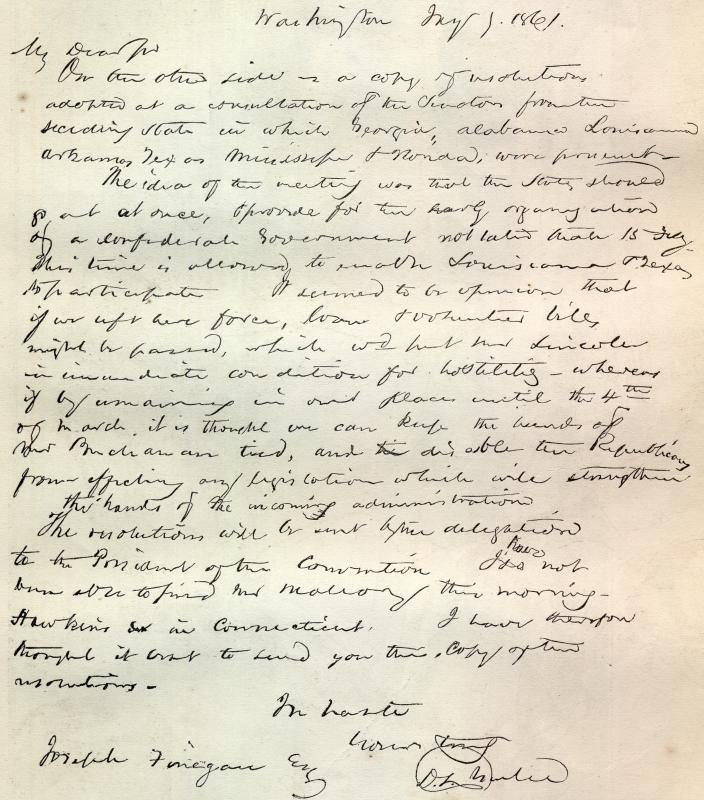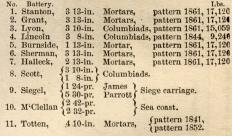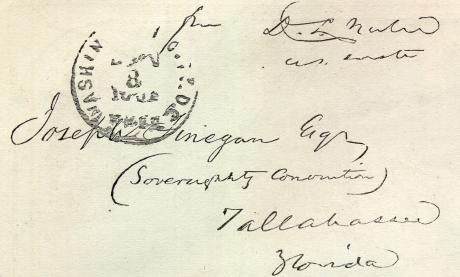The Merrimac's Second Trip
|
|
This Site:
|
HARPER'S WEEKLY. [MAY 3, 1862. 278 SENATOR YULEE'S LETTER.WE reproduce herewith a fac-simile of a remarkable letter from Senator Yulee to Joseph Finegan, of the "Sovereignty Conference" of Florida. This letter, which reveals the crooked purposes of the traitors who have plunged the country into the present war, was found by the correspondent of the New York Times at Fernandina, Florida, when the town was occupied by the Union forces. The following were the resolutions inclosed in the letter: Resolved—1. That in our opinion each of the Southern States should, as soon as may be, secede from the Union. Resolved—2. That provision should be made for a Convention to organize a Confederacy of the Seceding States, the Convention to meet not later than the 15th of February, at the City of Montgomery, in the State of Alabama. Resolved, That in view of the hostile legislation that is threatened against the Seceding States, and which may be consumated [sic in original, for it seems his secession mania extended even into orthography] before the 4th of March, we ask instructions whether the delegations are to remain in Congress until that date for the purpose of defeating such legislation. Resolved, That a Committee be and are hereby appointed, consisting of Messrs. Davis, Slidell, and Mallory, to carry out the objects of this meeting. CAPTURE OF FORT PULASKI.WE recorded the fall of Fort Pulaski, on 11th April, in our last Number. We now publish, on page 284, a series of views of the FORT and OUR BATTERIES, from sketches by Mr. Theodore R. Davis, and a PLAN by Lieutenant Haas. Mr. Davis, who was with General Gilmore when the batteries were being built, thus describes the work: Shortly after the occupation of Tybee Island by our troops, Captain (now General) Gilmore commenced the erection of a number of batteries for the reduction of Fort Pulaski. The majority of these batteries were for heavy mortars of thirteen inches calibre. Most of these were to be erected within easy range and sight of the fort. How to do this unseen was a matter of serious consideration, as the smallest party of men seen during the daytime at these places provoked the fire from the guns of Pulaski. This made it necessary that all work should be done at night. There being few natural advantages the slightest objects were made, by the ingenuity of General Gilmore, to serve as the basis of a fortification; during each night fences and bushes were carefully raised a foot or so at a time, and while no change in their appearance was observed from Fort Pulaski, a battery was in course of construction within from 1500 to 3000 yards. Whenever the transportation of one of the heavy mortars was interrupted by the approach of daylight it was carelessly covered up with bushes, and it remained undisturbed during the day. Some of these mortars weighed 17,000 pounds each; and the roads were so bad at first that the wheels of the trucks sunk into the mud up to the hubs. A corduroy road was afterward constructed, however, with fagots bound together, the interstices being filled with earth. Some of the guns were casemated, and all the batteries were carefully concealed from view. Not a loud word was spoken during their construction. Orders were given in an under-tone, and during the transportation of the artillery orders were transmitted by a whistle. It is supposed that the enemy were in total ignorance of the operations going on so near there until our guns opened upon the fort. The bombardment is thus described in the correspondence of the Herald: On Thursday morning, at twenty-three minutes of eight, the fire was opened by a discharge of a 13-inch mortar from Battery Halleck, fired by Lieutenant Horace Porter, of the Ordnance Department, the shell exploding in the air; and this was succeeded by a 13-inch shell from Battery Stanton, which exploded short. In a moment or two several of the mortars were discharged from the other batteries; but none of the shells were effective, the firing being wild and the fuses too short. Three minutes after the first fire Fort Pulaski responded from a 10-inch barbette gun, the shell exploding harmlessly over Tybee Island. The firing soon became general on both sides, little damage being done by either for some time, as we had not attained the correct range, and the enemy were not quite sure of the position of our battery. Soon, however, we observed the dust begin to fly from the pancope, between the south and southeast faces, and we were satisfied that the breaching batteries (Halleck, Scott, Siegel, M'Clellan, and Totten) on Goat Point were in full play, sending their rifled balls, solid 10-inch shot and heavy shell, with terrible effect against the brick walls. The bombardment went on all day, the fire from our batteries being more effective every minute. The enemy, finding that our 13-inch shells were not so destructive as they expected, began to work their barbette guns with great energy and give us some trouble. Our Parrott guns were brought to bear upon them, and a hot fire was poured upon their guns, and one or two of them dismounted. The fire from the breaching batteries became more and more disastrous to the enemy as the day advanced. The pancope began to assume a mottled aspect. It appeared to have the small-pox, blotches appearing all over it. These after a while ran together, and deep holes in the face of the wall of the pancope were discovered, which became deeper and deeper, and finally assumed the than of a breach. The breach at dusk, at which time the fire was temporarily suspended on both sides, was not entirely through the wall, except at one small point, through which a gleam of sunlight was caught about sunset. During the night an occasional shell was thrown from batteries Burnside and Halleck, and from the rifled guns of Battery Siegel. The enemy made no reply, but seemed to be engaged in repairing damages. We had lost not a man during the day, and sustained no damage of consequence to our batteries. Such as were injured were repaired by the engineers during the night, and all was made ready by daylight for another day's operations. At daylight on Friday fire was opened by our batteries, and responded to by the enemy. The James shells, which had well bored and honey-combed the pancope of the fort, had prepared it well for the operations of the solid 10-inch shot, and when the Columbiads from Goat Point opened the pancope began to crumble. The breach of the day previous enlarged, two others were effected, and by two o'clock, when the rebel flag was hauled down and the white flag raised, a practicable breach, large enough to drive a four-horse wagon through, had been formed, and our James shells were passing through it, across the terra plain, and breaching the magazine itself. This brought the rebels to terms. They unconditionally surrendered. The fort was much cut up by our firing. The breach was immense, and rifle-balls passed completely through it. No fort was ever breached before at so great a distance. The breaching batteries were as follows: FACSIMILE OF THE SUPERSCRIPTION OF THE LETTER. THE SECOND TRIP OF THE"MERRIMAC."WE publish on page 277 a series of sketches from Fortress Monroe, illustrating THE SECOND TRIP OF THE "MERRIMAC," which occurred on 11th inst. The various sketches explain themselves. Meanwhile we condense the following account of the cruise of the rebel iron-clad monster from the Herald correspondence: The long-expected reappearance of the rebel steamer Merrimac occurred yesterday morning. After a lapse of nearly five weeks in repairing damages sustained by her engagement with the Monitor, she returned to the Roads from Norfolk at 7 P.M. yesterday, accompanied by her consorts, the Patrick Henry, Yorktown, Teazer, Raleigh, and Empire. The signal-gun at the fortress was fired, and in a few minutes the garrison was under arms; and the artillerists, composed of detachments of the Naval brigade and Wisconsin artillery, soon after manned the guns on the parapet of the fortress. The large fleet of Union schooner transports which was anchored in the Roads on seeing the rebel fleet slipped their moorings, and, favored by wind and tide, were soon out of harm's way. Many of those in Hampton Cove, restricted by the narrow and serpentine channels, not being able to get out of the way of themselves, were assisted by the steam-tugs, of which there are a number here. The little Monitor, which has been anxiously awaiting the reappearance of the Merrimac, on seeing the latter approach, got ready for action by clearing her decks, lowering her smoke and steam pipes, slipping her anchor, and in less than ten minutes was ready for action. The orders from Flag-officer Goldsborough were, however, to act strictly on the defensive, and to give battle only when the rebel craft should approach a given point. The Merrimac and her consorts meanwhile had approached to within four miles of the fortress, and there she stopped, having, as it afterward proved, a certain boundary, without the range of the guns of the fort, over which she would not pass. The French war steamer Catinet, which was anchored near the Monitor when the Merrimac hove in sight, and was taking in water from a Union schooner, took up her anchor, and, taking the schooner under the protection of her flag, proceeded to a point between here and Newport News, where she had already been preceded by the French war steamer Gassandi and the British steamer Rinaldo. The steam transports State of Maine, Mystic, South America, and others, with troops, were in the harbor, but soon moved to a haven of safety out of the range of the threatened point. The Monitor, in her defensive attitude, joined by the Stevens battery Naugatuck, steamed around in the Roads, at times showing their broadsides defiantly at the rebel fleet. The rebel fleet seemed to take a cowardly advantage of the presence of the foreign vessels in the Roads, and kept continually under their cover, so that, had our policy been on the offensive, we could not have fired a shot at the rebels without endangering the neutral vessels. Things remained pretty much in statu quo, the rebel fleet backing and filling, at times running up to the Merrimac for orders, and then steaming away. At 9 o'clock A.M. the rebel gun-boat Patrick Henry left the fleet and ran into Hampton Cove by the inside channel, leading from Newport News Point toward Hampton village. At first it seemed to be a manoeuvre to induce the Monitor to change her position; and others supposed the rebel steamer had hostile designs on the Federal camp at Hampton (Camp Hamilton). The sequel to the problem was soon discovered when the rebel craft, subsequently joined by the rebel steamer Teazer, were seen cutting out two Union brigs and a schooner, which were at anchor about two miles from shore. The affair was deeply humiliating, and no efforts were made by our fleet to prevent the outrage until after the rebel steamers were escaping with their prizes and under full headway for Norfolk, when the gun-boats Octarora and Naugatuck were sent up Hampton Cove to a point near where the stolen vessels had been anchored. The Patrick Henry towed her prizes to Norfolk, and returned to join the rebel fleet shortly after 12 M. A large number of rebel excursionists on steamers followed the fleet down from Norfolk to see the fun; but they were doomed to disappointment, as no fight occurred. The Merrimac and her rebel consorts returned to Norfolk from the Roads at half past 5 o'clock, without having induced our fleet, including the Monitor, to give them battle on unequal grounds. Before leaving, however, she exchanged a few shots, at long range, with the Union gun-boats Octarora and Stevens battery Naugatuck, the latter lying at anchor in Hampton Cove. The practice of the Merrimac was very poor, her best gun not throwing a shot over three miles, while her opponents threw shot over three and a half miles—the Naugatuck, with her superior 100-pound Parrott gun, throwing even further. It is understood that the great gun of the Merrimac exploded on 11th.
MAP OF YORKTOWN AND ITS
|
||||||||||||||||||||||||||||||
|
|
||
|
|
Site Copyright 2003-2018 Son of the South. For Questions or comments about this collection, contact paul@sonofthesouth.net |
|
|
Are you Scared and Confused? Read My Snake Story, a story of hope and encouragement, to help you face your fears. |
||
